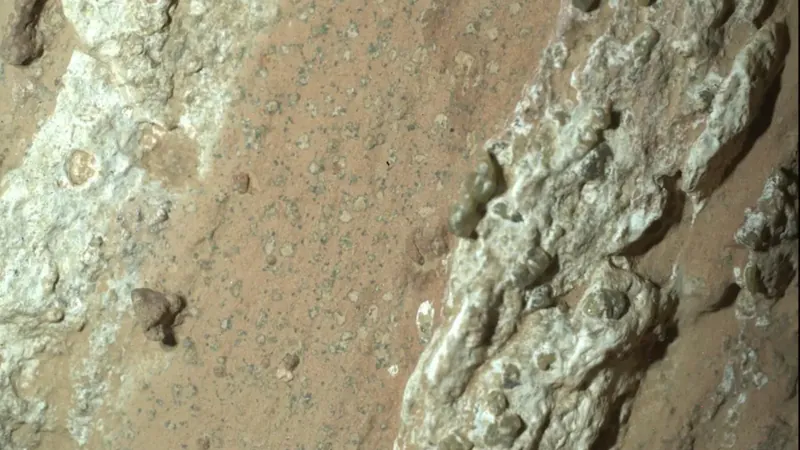
Unveiling Mars' Secret: Could Jezero Crater Have Once Harbored Life?
2025-09-19
Author: Mei
Mars' Thrilling New Discovery: Signs of Life?
Just over a week after the groundbreaking announcement that NASA's Perseverance rover detected a potential biosignature in a Martian rock known as Sapphire Canyon, new revelations have emerged surrounding Jezero Crater. Scientists now believe that this ancient lakebed once had widespread habitable conditions, igniting excitement in the quest for Martian life.
The Fascinating Findings
In a compelling new study, researchers have pinpointed 24 minerals that characterize Jezero's shifting environment, showcasing its volcanic origin and dynamic history with water. While this research doesn't delve into the Sapphire Canyon sample directly, it highlights multiple instances of water activity capable of supporting life.
Eleanor Moreland, the lead author from Rice University, emphasized, "There were multiple occasions in Mars' history when these volcanic rocks interacted with liquid water, suggesting this location could have hosted life-friendly environments more than once."
A Mineralogical Chronicle of Water and Life
Drawing upon three years of data collected by Perseverance—which has been exploring Jezero since its landing in 2021—scientists utilized the rover’s X-ray instrument and a novel algorithm called MIST to catalog these minerals and construct a 'mineralogical archive' of the crater.
Minerals are remarkable storytellers formed under unique conditions of temperature and chemistry, and the study detailed how Jezero experienced three distinct stages of water-rock interaction, revealing progressive implications for potential habitability.
Extreme Conditions, Yet Hopeful Signs
The study found that the oldest rocks in Jezero showed signs of hot, acidic fluids—a hostile environment that would be challenging for any form of life. However, co-author Kirsten Siebach noted, "These extreme conditions do not rule out habitability. On Earth, life thrives in even the most acidic environments like those found in Yellowstone."
Later mineral formations in cooler waters revealed conditions significantly more conducive to microbial life, and the presence of sepiolite—indicative of low-temperature, alkaline waters—suggests a history of favorable environments for life.
The Quest for Life Beyond Earth
This study adds context to last year's compelling findings at Cheyava Falls, where Perseverance discovered conditions often associated with microbial life. While researchers are careful to differentiate between biological and non-biological phenomena, ongoing analyses on Earth are crucial to settling the debate.
Katie Stack Morgan, Perseverance Project Scientist, stated, "We're nearing the limits of what our rover can achieve on the surface. Our findings aim to set the stage for further exploration back on Earth."
What Lies Ahead?
The mission has collected numerous samples that may hold essential clues about Martian life. However, uncertainties remain regarding the timeline and logistics of returning these samples to Earth. NASA is exploring cheaper alternatives to its Mars Sample Return program, which is currently facing budget cuts.
Meanwhile, China is advancing its own Mars sample-return mission, potentially racing ahead to secure the first Martian samples. If successful, this could revolutionize planetary science and reflect a significant leap in space exploration.
Innovative Techniques Transforming Discovery
The introduction of the MIST algorithm not only enhances our understanding of Mars' mineral composition but will also play a pivotal role in determining which samples will be prioritized for return. By cataloging these findings, future Mars missions will be better equipped to identify the most promising clues in the search for extraterrestrial life.
This remarkable journey continues as scientists unravel the mysteries of the Red Planet, bringing us closer to answering the age-old question: Did life ever exist on Mars?



 Brasil (PT)
Brasil (PT)
 Canada (EN)
Canada (EN)
 Chile (ES)
Chile (ES)
 Česko (CS)
Česko (CS)
 대한민국 (KO)
대한민국 (KO)
 España (ES)
España (ES)
 France (FR)
France (FR)
 Hong Kong (EN)
Hong Kong (EN)
 Italia (IT)
Italia (IT)
 日本 (JA)
日本 (JA)
 Magyarország (HU)
Magyarország (HU)
 Norge (NO)
Norge (NO)
 Polska (PL)
Polska (PL)
 Schweiz (DE)
Schweiz (DE)
 Singapore (EN)
Singapore (EN)
 Sverige (SV)
Sverige (SV)
 Suomi (FI)
Suomi (FI)
 Türkiye (TR)
Türkiye (TR)
 الإمارات العربية المتحدة (AR)
الإمارات العربية المتحدة (AR)